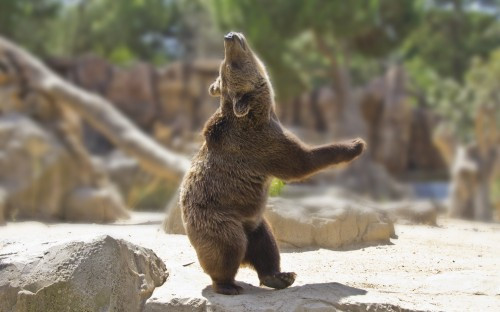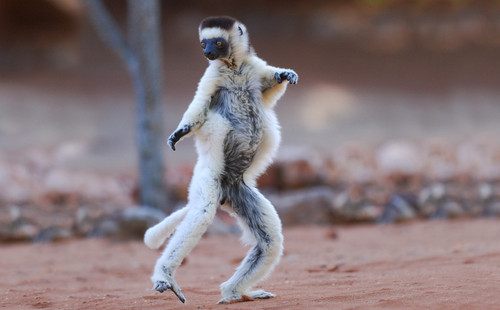Have you ever imagined a monkey grooving to music? It might sound like a scene from a cartoon, but the reality is far more fascinating. Scientists are increasingly exploring the ability of various animals, including our primate cousins, to synchronize with auditory beats – essentially, to dance. This revelation opens a window into the complex cognitive abilities of animals and challenges our understanding of rhythm and movement in the natural world.
This exploration into animal rhythm was highlighted at the annual conference of the American Association for the Advancement of Science, where researchers discussed which species can truly “get their groove on.” While the list of animals known to possess this rhythmic capability is still growing, it already includes some surprising members. Beyond just a cute spectacle, this behavior could unlock crucial insights into fundamental mental processes shared between humans and other species.
It’s easy to anthropomorphize animal movements, seeing rhythm where there might only be random motion or reactions to sound. As Peter Cook from the University of Santa Cruz points out, just because it looks like an animal is moving to a beat doesn’t automatically mean they are actually synchronizing with it. True “dancing,” in a scientific sense, requires an animal to anticipate and move in time with a perceived beat.
 Macaque monkey appearing to dance with arms raised
Macaque monkey appearing to dance with arms raised
However, evidence is mounting that certain animals, particularly primates, can indeed move rhythmically to music. Macaques, for instance, have been observed tapping out rhythms, often preferring auditory cues over visual ones. Studies have shown that they can learn to synchronize their movements to a beat, although they sometimes find it challenging. This learning process itself is significant, suggesting a level of cognitive flexibility and adaptability in primates when it comes to rhythm perception and motor control.
Edward Large of Florida Atlantic University draws an interesting parallel with human development. He notes that young children, much like animals initially observed at places like Sea World, may move to music but often lack the ability to truly synchronize with the beat. This synchronization, he argues, develops through social interaction and learning. Dancing, in this context, becomes a fundamental form of social coordination, whether it’s with another dancer or simply in response to the music.
The study of rhythmic abilities in animals, especially Monkeys Dancing, reveals a fascinating spectrum of capabilities. Chimpanzees, close relatives of macaques and humans, have also shown an aptitude for rhythm. They have been known to tap out rhythms to music or even in response to a researcher tapping a drum. Interestingly, their preferred tempo often hovers around 280 beats per minute, a pace that might surprise those familiar with typical dance music tempos.
Hugo Merchant from the Autonomous National University of Mexico has conducted significant research with macaques, further solidifying the understanding of primate rhythmic ability. His work highlights the challenges macaques face in learning to synchronize with a beat, yet also underscores their capacity to learn and adapt to auditory rhythms. This research is crucial for understanding the neural mechanisms underlying rhythm perception and production in primates.
 Two monkeys grooming each other, one appearing to have a relaxed, dancing posture
Two monkeys grooming each other, one appearing to have a relaxed, dancing posture
Beyond primates, the animal kingdom continues to surprise us with its rhythmic talents. Cook himself trained a sea lion to recognize and respond to the rhythm of the Backstreet Boys, a surprising musical choice that is also known to have inspired Snowball, the dancing cockatoo. This diverse range of species capable of beat synchronization suggests that the underlying mechanisms for rhythm perception might be more widespread than previously thought.
The question then arises: what is the evolutionary significance of this ability? Is it merely a curious quirk, or does it serve a more fundamental purpose? Brain imaging studies reveal that specific brainwaves synchronize with a beat when an animal or person is listening to music. But what adaptive advantage could this provide? While the precise evolutionary reasons are still unclear, theories suggest that the ability to coordinate with others is crucial for social bonding and group cohesion.
Dimitri Christakis at the University of Washington proposes the concept of an “internal metronome,” a kind of internal clock that helps us gauge the pace of events in the world. He suggests that this internal metronome might be linked to our ability to move in rhythm. Could the capacity for rhythm and dance be a precursor to language or a vital component of communication? It’s a compelling idea, suggesting that monkeys dancing and other animals displaying rhythmic behavior are not just engaging in amusing antics, but potentially revealing deep-seated cognitive and communicative abilities.
 A cockatoo, Snowball, famous for dancing, perched on a hand
A cockatoo, Snowball, famous for dancing, perched on a hand
While we are only beginning to scratch the surface of understanding animal rhythm and “monkeys dancing,” the research is opening exciting new avenues for exploring animal cognition and the evolutionary roots of rhythm and movement. Perhaps further investigation will reveal even more surprising dancers in the animal kingdom and deepen our appreciation for the complex minds of creatures great and small.
Photo Credit: Shutterstock
